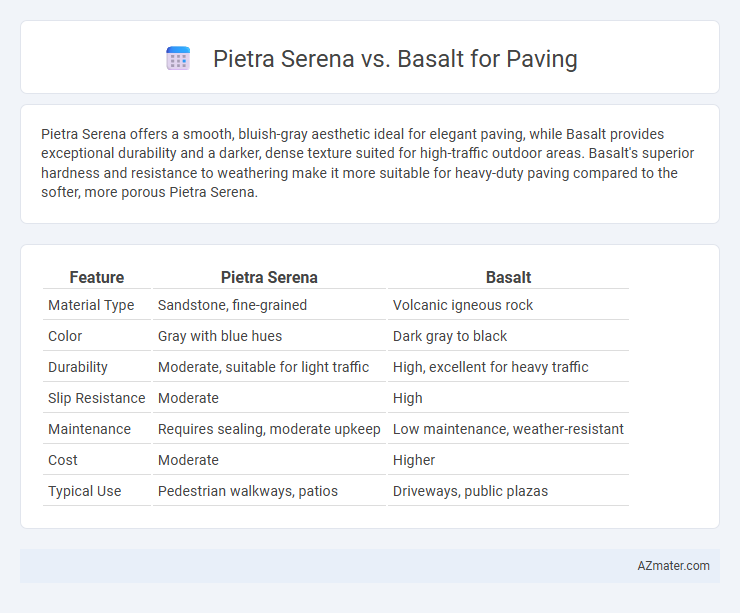Pietra Serena offers a smooth, bluish-gray aesthetic ideal for elegant paving, while Basalt provides exceptional durability and a darker, dense texture suited for high-traffic outdoor areas. Basalt's superior hardness and resistance to weathering make it more suitable for heavy-duty paving compared to the softer, more porous Pietra Serena.
Table of Comparison
| Feature | Pietra Serena | Basalt |
|---|---|---|
| Material Type | Sandstone, fine-grained | Volcanic igneous rock |
| Color | Gray with blue hues | Dark gray to black |
| Durability | Moderate, suitable for light traffic | High, excellent for heavy traffic |
| Slip Resistance | Moderate | High |
| Maintenance | Requires sealing, moderate upkeep | Low maintenance, weather-resistant |
| Cost | Moderate | Higher |
| Typical Use | Pedestrian walkways, patios | Driveways, public plazas |
Introduction to Pietra Serena and Basalt
Pietra Serena is a fine-grained, blue-gray sandstone renowned for its smooth texture and elegant appearance, commonly used in Tuscan architecture and paving for its durability and classic aesthetic. Basalt, a dense volcanic igneous rock, offers exceptional hardness, weather resistance, and a darker tone, making it ideal for high-traffic outdoor paving applications requiring longevity. Both materials provide distinct benefits in paving, with Pietra Serena favored for sophisticated designs and Basalt preferred for robust, long-lasting surfaces.
Geological Origins and Composition
Pietra Serena, a siliceous sandstone predominantly found in Tuscany, is characterized by its fine grain and uniform texture, originating from sedimentary processes during the Miocene epoch. Basalt, an extrusive igneous rock formed through rapid cooling of basaltic lava, features a dense, fine-grained crystalline structure rich in iron and magnesium minerals. The geological origins of these stones influence their composition, with Pietra Serena offering a smoother, more workable surface ideal for elegant paving, while basalt provides exceptional durability and resistance due to its volcanic mineralogy.
Color and Aesthetic Differences
Pietra Serena offers a soft, bluish-gray hue with subtle veining that creates an elegant, refined appearance ideal for classic and Tuscan-style paving designs. Basalt features a deep, rich black or charcoal color with a more uniform texture, lending a modern, sleek aesthetic that enhances contemporary and minimalist landscapes. Color retention varies slightly, as Pietra Serena may lighten over time due to weathering, while basalt generally maintains its dark tone, preserving its bold visual impact.
Durability and Weather Resistance
Pietra Serena, a fine-grained sandstone, offers moderate durability and good weather resistance, making it suitable for pavements in mild to moderate climates. Basalt, an igneous volcanic rock, exhibits exceptional hardness, superior durability, and high resistance to weathering, ideal for high-traffic and harsh environmental conditions. Its dense structure minimizes water absorption, reducing freeze-thaw damage and ensuring long-lasting pavement performance.
Slip Resistance and Safety
Pietra Serena offers moderate slip resistance due to its fine-grained texture, making it suitable for areas with light foot traffic but requiring maintenance to prevent slipperiness when wet. Basalt demonstrates superior slip resistance because of its dense, rough surface, providing enhanced safety in high-traffic or wet environments. Choosing basalt for paving maximizes durability and reduces slip hazards, crucial for outdoor public spaces and commercial walkways.
Installation and Workability
Pietra Serena offers greater ease of installation due to its uniform texture and lighter weight, enabling quicker cutting and shaping for precise paving layouts. Basalt, being denser and harder, requires specialized tools for cutting and drilling, which can increase labor time and complexity during installation. The superior workability of Pietra Serena makes it a preferred choice for intricate designs, while basalt's durability suits high-traffic areas despite more challenging handling.
Maintenance and Longevity
Pietra Serena offers moderate durability with a smooth finish that requires regular sealing to prevent staining and weathering, making its maintenance more frequent but manageable. Basalt, known for its exceptional hardness and dense composition, provides superior resistance to wear and environmental factors, resulting in lower maintenance demands and extended longevity for paving applications. The natural properties of basalt contribute to its long-lasting performance, while Pietra Serena's softer texture necessitates more attentive care to preserve its aesthetic appeal over time.
Environmental Impact and Sustainability
Pietra Serena and Basalt differ significantly in their environmental impact and sustainability profiles when used for paving. Pietra Serena, a sandstone with moderate quarrying emissions and good durability, offers lower embodied energy compared to Basalt, a dense volcanic rock known for its high strength and long lifespan, which contributes to less frequent replacement and reduced resource use over time. The sustainable appeal of Basalt stems from its robustness and resistance to weathering, whereas Pietra Serena supports eco-friendly projects through its lighter quarry footprint and natural availability in regional contexts.
Cost Comparison and Value for Money
Pietra Serena offers a moderate cost for paving materials, typically priced between $15 to $30 per square foot, making it an attractive choice for those seeking aesthetic appeal combined with affordability. Basalt, often costing upwards of $25 to $50 per square foot, provides exceptional durability and resistance to wear, delivering long-term value despite higher initial expenses. Evaluating cost per lifespan and maintenance needs reveals Pietra Serena as cost-effective for decorative projects, whereas Basalt ensures superior return on investment in high-traffic or commercial paving applications.
Best Applications for Pietra Serena and Basalt in Paving
Pietra Serena is ideal for paving in historic and high-end residential projects due to its elegant gray tones, smooth texture, and ease of cutting, making it suitable for patios, walkways, and courtyards requiring aesthetic appeal and moderate durability. Basalt, known for its exceptional hardness, dark color, and resistance to weathering, excels in high-traffic urban paving applications, commercial plazas, and outdoor areas exposed to heavy wear and harsh environmental conditions. Selecting Pietra Serena enhances projects prioritizing visual refinement, while basalt offers superior longevity and strength for demanding paving surfaces.

Infographic: Pietra Serena vs Basalt for Paving
 azmater.com
azmater.com